Volume I (all by Phiz)
- 'The Balcony at Basle'. Source: 1989 Trollope Society edition of
Can You Forgive Her?, Frontispiece. Reprinted Hennessey,
p. 297:
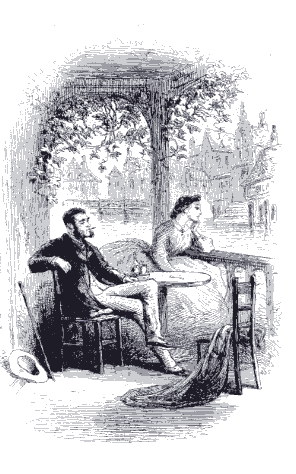 Habl˘t Browne (Phiz), The Balcony at Basle"
Habl˘t Browne (Phiz), The Balcony at Basle"
Very effective piece of line drawing. We see
George and Alice Vavasour by the water's edge on the balcony; it is
a pivotal moment in the novel. The faces are alive with feeling which
is psychologically ambiguous, calm, quiet, intent. The mood is one
of languor and dream.
- '"Would you mind shutting the window?"'. Source: 1989 Trollope Society edition of
Can You Forgive Her?, facing p. 10. The scene as depicted
literally repeats some of the gestures in the scene, but the piteous look
on the old woman's face and the disdainful calm on the young woman's is
not at all appropriate to Alice Vavasour's vexation or her aunt Lady
Macleod's peremptory indignation and demands. As a drawing of figures,
it's accurate. Alice is given dark hair.
- '"Sometimes you drive me to hard". Source: 1989 Trollope Society edition of
Can You Forgive Her?, facing p. 26. This is
laughably wrong. Kate is made lachrymose and disdainful, while Alice
looks lifeless. Phiz does not seem to have understood the pyschology
of the serious scenes in the novel at all.
- '"Peace be to His Manes"'. Source: 1989 Trollope Society edition of
Can You Forgive Her?, facing p. 60. This one is
supposed to be funny. The widow looks really grief-striken; she is
made large and still. The maid has a certain living curiosity in her
face. Kate seems to be asking herself what she should do next.
The idea of a inward disparity between gesture and psychology which
has subtle yet parodic implications is beyond this artist.
- '"Captain Bellfield Proposes a Toast". Source: 1989 Trollope Society
edition of Can You Forgive Her?, facing p. 78. Reprinted and
discussed Hall, AT and His Illustrators, pp. 93-94.
This external scene, with its vivacity, comic gestures, and sense of energy
which can be caught through lines adds life to Trollope's own scene.
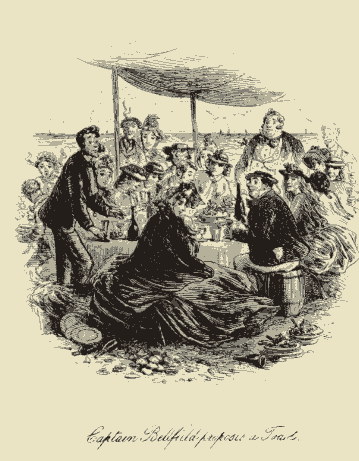 Habl˘t Browne (Phiz), "Captain Bellfield Proposes a Toast"
Habl˘t Browne (Phiz), "Captain Bellfield Proposes a Toast"
- '"If it were your friend what advise would you give me?"' Source: 1989
Trollope Society edition of Can You Forgive Her?, facing p. 100 .
Another one within Phiz's range as the outward gesture does
reflect the inward reality of the scene. There is a nobility in John
Grey as he speaks (though the male figure's face is made too old,
too many lines given)l there is an appropriate dullness in Alice's face.
- '"I'm as round as your hat, and as square as your elbow; I am"'.
Source: 1989 Trollope Society edition of Can You Forgive Her?,
facing p. 112.
Phiz's art cannot accommodate the seriousness
of Trollope's depiction of Grimes with its sardonic yet realistic
humour; Grimes becomes a kind of mild silly-smiling caricature of
a round man. This does for Cheesacre, not for grasping practical
and ruthless nature of Trollope's slightly cringing campaign manager
as he explains himself to George Vavasour. Scruby too much the
gentleman and too old. George maintains the beard from the frontispiece.
- '"Mrs Greenhow, look at that"". Source: 1989 Trollope Society edition
of Can You Forgive Her?, facing p. 121. This does not
come off. The widow looks like she is holding marbles in her mouth; her
eyes are closed. Cheeseacre looks detached, relaxed. Not comic.
- 'Edgehill'. Source: 1989 Trollope Society edition of Can You
Forgive Her?, facing p. 148. Reprinted and discussed Hall, AT and His
Illustrators, pp. 96-98:
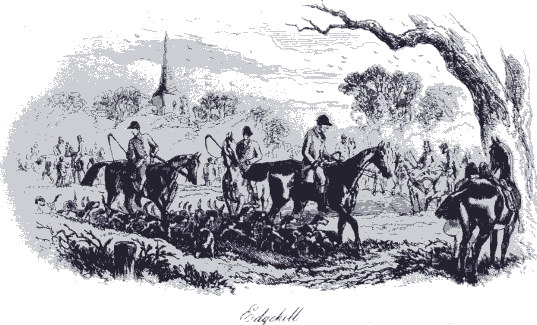 Habl˘t Browne (Phiz), "Edgehill", Can You Forgive Her?
Habl˘t Browne (Phiz), "Edgehill", Can You Forgive Her?
This is the second hunting
scene (of four in all Trollope's novels); it constitutes one of the
two most frequently-reprinted of the original illustrations to Trollope's
novels (for the other, see Annotated Commentary I, 'Monkton Grange' by
Millais for Orley Farm). As with Millais', it is attractive,
filled with energy, verve. It is more successful than Millais', if a
sense of movement is what's wanted. As said above, the attention paid
to such a piece belies the reality and nature of Trollope's novels
centrally, of the gist of their stories and characters.
- '"Arabella Greenow, will you be that woman?" Source: 1989 Trollope
Society edition of Can You Forgive Her?, facing p. 184.
This depiction of Mr Cheesacre asking Mrs Greenow to marry
him has a delicacy of approach in the lines given Mr Cheesacre's
face. The widow sits on a couch and appears to be barely paying
any attention to him at all. Again it's not bad because the outward
gesture can stand for the inward reality.
- '"Baker, you must put Dandy on the bar"'. Source: 1989 Trollope
Society edition of Can You Forgive Her?, facing p. 194.
This elegant depiction of Lady Glencora's carriage and
beautiful horses strikes the note of luxury and animal life wanted.
The problem is Lady Glen's face is without life.
- '"Mr Palliser, that was a cannon"'. Source: 1989 Trollope
Society edition of Can You Forgive Her?, facing p. 209.
Again Phiz seeks the note of luxury, of elegance, of
wealth in the clothes, the depiction of the billard table. We
have a crowd; a man stands on the side in earnest talk with a
female who seems to be coyly looking within herself.
- '"The most self-willed young woman I ever met in my life"'.
Source: 1989 Trollope Society edition of Can You Forgive Her?,
facing p. 242. Reprinted Trollopiana, 27, p. 29.
This has the same problem the earlier depiction of
Alice versus an older woman has: the older woman becomes a comic
caricature who looks sad and bewildered, not at all an oppresive
figure. Alice appears to be quietly thinking to herself. Phiz's
art cannot accommodate complex psychology of resentment, domineering,
without exaggeration, and exaggeration is what Trollope didn't want.
- "The Priory Runs". Source: 1989 Trollope Society edition of
Can You Forgive Her?, facing p. 246. This one deserves
to be better known; it is an instance where Phiz reaches for and
obtains through lines the psychological picturesque. The lovely
playful depiction of the greenery, the dissolving gothic arch provide
an appropriate frame for the blond young woman who looks down
at the ground with a resentful dismayed expression. Alice's
larger figure comforting her looks forward to Mary Ellen Edwards'
depiction of a similar scene between Julia, Lady Ongar and
Florence Burton at the close of The Claverings (see
Annotated Commentary 3, 'Lady Ongar and Florence' and my
Trollope on the Net, Chapter 5.
- 'Burgo Fitzgerald'. Source: 1989 Trollope Society edition of
Can You Forgive Her?, facing p. 262. Reprinted and discussed
Hall, AT and His Illustrators, pp. 91-93. Also reprinted
Hennessey, p. 253; the frontispiece to my Trollope on the Net:
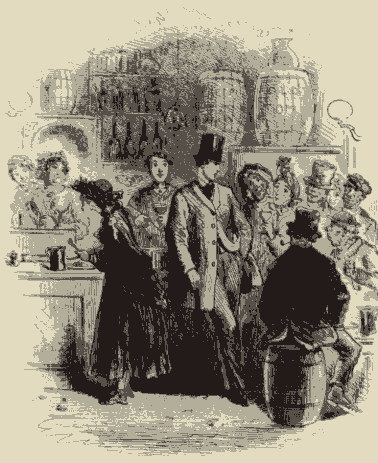 Habl˘t Browne (Phiz), Can You Forgive Her?
Habl˘t Browne (Phiz), Can You Forgive Her?
Once again the outward gestures really mirror the inward
realities of the scene -- as do the costumes. However, this does not
account for the reality that this is arguably one of the best of the
original illustrations of Trollope's novels. As with Millais's
'Lady Mason after her Confession' for Orley Farm
and Stone's 'Trevelyan at Casalunga' for He Knew He Was Right
(see Annotated Commentaries 1 and 3), the artist has himself entered
the inner reality of the participants in ways that are closely
analogous to Trollope's own in his novels. See Trollope on the Net, Chapter 6.
- 'Swindale Fell'. Source: 1989 Trollope Society edition of
Can You Forgive Her?, facing p. 284:
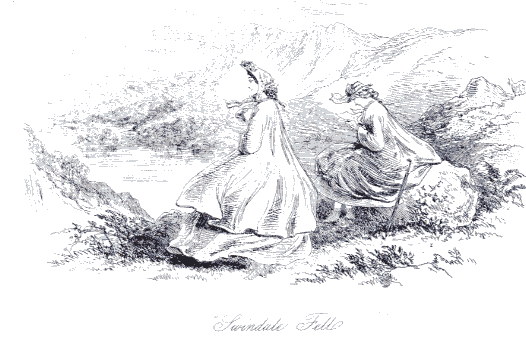 Habl˘t Browne (Phiz), "Swindale Fell"
Habl˘t Browne (Phiz), "Swindale Fell"
This
has all the graces and attempt at inward interest of 'Priory
Ruins', but the deep-musing nature of Trollope's use of inner
light and the two women intent upon letters and memory cannot
be accommodated in the distanced line flat line drawing with
small figures. See my discussion in Trollope on the Net,
Chapter 6.
- '"I have heard -- said Burgo"'. Source: 1989 Trollope Society edition
of Can You Forgive Her?, facing p. 300.
This scene
of a group of men around the table is awkward and has no central
mood. The Burgo figure looks pettily annoyed; Cosimo Monk looks
startled in a comic way; one male with long moustaches has a pained
expression on his face. Phiz does not know what to do with such
a complicated depiction of psychologies interacting through social
gestures.
- '"Then -- then -- then let her come to me"' Source: 1989 Trollope
Society edition of Can You Forgive Her?, facing p. 330.
John Grey now too young and too theatrically melancholy;
Mr Vavasour too graceful and conventional a figure. Phiz is trying
for the gesture of loyalty amid companionship between two men.
- '"So you've come back, have you?" -- said the Squire'. Source:
1989 Trollope Society edition of Can You Forgive Her?, facing
p. 351. This one does not come off at all. Squire Vavasour looks
weak and sadly dismayed, not angry, not indignant. There's no energy
here. Goerge is expressionless, overshadowed by his hat. Kate
looks away, a kind of pinhead on a cape.
- '"Dear Greenhow! dear Husband!"'. Source: 1989 Trollope Society
edition of Can You Forgive Her?, facing p. 368. This one
is occasionally reprinted in studies of book illustrations and Victorian
comic depictions of social life, though not in Trollope studies.
It is effective. Phiz has a feel for Captain Bellfield as a devil-
may-care scamp; he is depcited a man in his thirties, a bit tired,
but looking at Mrs Greenow with a kind of gallant fondness and
animation. Behind the couch on which Mrs Greenow and the Captain
sit, we see Kate conversing (from the side) with a slightly dismayed
Cheesacre. The comic expression seems right. The irony is Mrs
Greenow is lamenting over her husband's picture. But for his
money none of this would take place. She's enjoying it.
Volume II (all by Miss E. Taylor)
- 'Great Jove'. Source: 1989 Trollope Society edition of Can You
Forgive Her?, facing p. 382. Reprinted and discussed Hall,
AT and His Illustrators, pp. 98-99.
It's a match
in mood and significance for Millais's 'The Board' (see above,
The Small House at Allington). It is good because it too
captures the banality and indifference of everyday life in Parliament. The man who holds the
position and wears the clothes
others so want sits and sleeps; others talk and argue and kill time
as they can. There is reality in the psychology of the faces.
- "Friendships will not come by ordering", said Lady Glendora'.
Source: 1989 Trollope Society edition of Can You Forgive Her?,
facing p. 388. Miss Taylor's Lady Glen is much larger, rounder,
impressive; unfortunately, the expression on her face isone of silent
annoyance instead of poignant resentment as she tells the simple
truth.
- '"I asked you for a kiss"'. Source: 1989 Trollope Society edition
of Can You Forgive Her?, facing p. 426. The
psychology of George's face all wrong. He does not look frightening,
only distressed. He leans over as if to make an impression, and
Alice sews on as if she feels nothing but a slight upset. The depiction
of brutal violence is not found in any of the illustrations to Trollope's
novels -- though it happens frequently enough in his stories.
- 'Mr Cheesacre disturbed'. Source: 1989 Trollope Society edition
of Can You Forgive Her?, facing p. 435. In her
rounded psychological in-depth style, Miss Taylor reaches for the
same mood and sources of comedy we find in '"Dear Greenhow! dear
Husband!"'. Perhaps the thinner figures are more effective; Miss
Taylor's faces are not as alive; her Captain Bellfield is too
sentimentally engaged around the eyes.
- '"All right,", said Burgo, as he thrust the money into his breast
pocket'. Source: 1989 Trollope Society edition of Can You Forgive
Her?, facing p. 449. Lady Monk is well done; her
expression of interest is just right. The figure is wholly believably
dressed. She looks slightly irritated yet expectant. The problem is
with Burgo: our insouciant rake has turned into a young plump blond
man with a sentimental expression on his curiously feminine face. right.
- 'Mr Bott on the watch'. Source: 1989 Trollope Society edition
of Can You Forgive Her?, facing p. 459. This
is not bad; the viewer's attention is fixed on the darker fully
detailed figure of Bott seeming looking at a couple slightly sketched
in the distance while he stands very close to Lady Glen seen from
the bakkc with Burgo making an intent appeal as they sit with their
faces and upper bodies facing and close to one another. Here Burgo's
face is hard.
- 'The Last of the old Squire'. Source: 1989 Trollope Society edition
of Can You Forgive Her?, facing p. 484. A death scene. The old man looks like a
real old
man who has just sunk back; Kate looks weary as she watches. It is
dark, gloomy, still.
- 'Kate'. Source: 1989 Trollope Society edition of Can You
Forgive Her?, facing p. 517. Reprinted and discussed in
Deborah Denenholz Morse's Women in Trollope's Palliser's
Novels, pp. 35-37:>
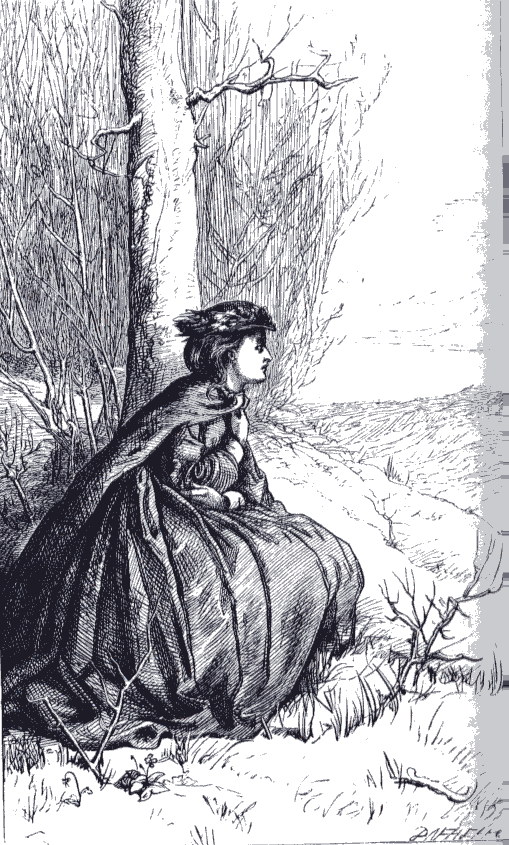 Miss E. Taylor, "Kate"
Miss E. Taylor, "Kate"
This, 'Lady
Glencora' and 'Ailce' are discussed in my Trollope on the
Net, Chapter 6, as effective deeply-felt visualisations of
women who are being deprived of something deeply, privately-meaningful
to themselves, women in reverie. Each is detailed appropriately
and the poses are set up in parallel analogies. The one of
Kate is unusual for showing a woman just after brutal violence,
calming down.
- 'Lady Glencora'. Source: 1989 Trollope Society edition
of Can You Forgive Her?, facing p. 530. Reprinted
and discussed in Hall AT and His Illustrators, p 100-1;
Morse, Women in Trollope's Palliser's Novels, pp. 100-4:
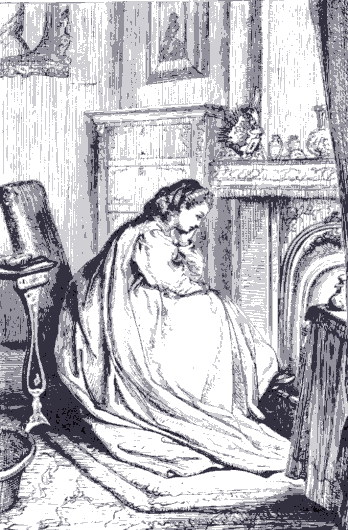 Miss E. Taylor, "Lady Glencora". Can You Forgive Her?
Miss E. Taylor, "Lady Glencora". Can You Forgive Her?
On this: Miss Taylor has been
careful to follow Trollope's detailed visualisation of Lady Glen
at the moment she has to face her half-spontaneous decision,
which was to stay with Plantagenet and safety. It may be compared
with Millais's depiction of Laura Kennedy in Phineas Finn, '"So
she burned the morsel of paper"' (see Annotated Commentary
3). Bachelard's commentary on reveries in front of fireplaces
is also appropriate for understanding why these visualisations
take the kind of mood and show the kind of details we see
here.
- '"Before God, my first wish is to free you from the misfortune I
have brought on you"'. Source: 1989 Trollope Society edition
of Can You Forgive Her?, facing p. 536. Reprinted
and discussed in Morse, Women in Trollope's Palliser's Novels,
pp. 100-4. This emphasis on Lady Glen's guilt for not
having become pregnant, for loving Burgo and not the very handsome
young lord with his kind gravity and intelligence Miss Taylor has
depicted is revealing of how the average woman of Trollope's era would
have seen Lady Glen's predicament. They took her childlessness seriously;
she was not fulfilling her duty to him. I find this illustration
touching.
- 'She managed to carry herself with some dignity'. Source:
1989 Trollope Society edition of Can You Forgive Her?, facing
p. 576. Again Miss Taylor has given Trollope's women
real dignity, intelligence on their faces. Alice is made sombre,
yet not theatrical. It is just right for the text.
- '"A sniff of the rocks and valleys"'. Source: 1989 Trollope
Society edition of Can You Forgive Her?, facing p. 581.
Miss Taylor can capture Captain Bellfield's nervousness,
but not his rakish quality. There is something emasculated about
the depiction of his body; it is enfeebled. (The Trollope Society
edition has misplaced this in a chapter on Grey and Alice.)
- '"I wonder when you're going to pay me what you owe me, Lieutenant
Belfield". Source: 1989 Trollope Society edition of Can You
Forgive Her?, facing p. 596. My comment: again, except for
the lakc of savoir-faire and nonchalance in Bellfield (who looks
merely anxious), and the still dignity of Mrs Greenow's face
(an aspect of this idyllic style), the picture is not bad. It does
put Cheesacre's indignation to the fore.
- 'Lady Glencora at Baden'. Source: 1989 Trollope Society edition
of Can You Forgive Her?, facing p. 627:
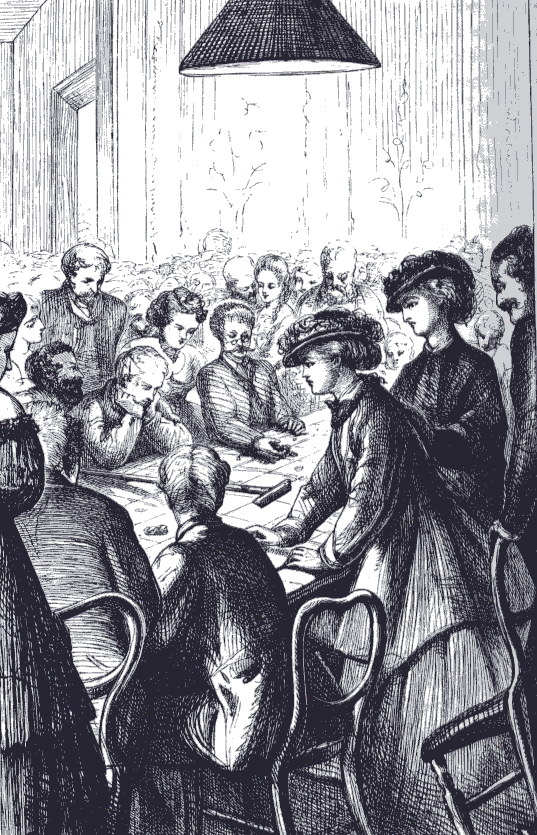 Miss E. Taylor, "Lady Glencora at Baden"
Miss E. Taylor, "Lady Glencora at Baden"
This
one should be better known; it is a superb depiction of an important
moment in Lady Glen's experience. It is alive with tension, well drawn.
There's a grim shadow around Lady Glen's face at the table which suggests
the consequences of the adventures she seeks. It is really a piece of
unfair prejudice which dismisses Miss Taylor as inadequate; it is not
even anti-feminism. She is dismissed because she is unknown, has
no name, is nobody.
- 'Alice'. Source: 1989 Trollope Society edition.f Can You
Forgive Her?, facing p. 644:
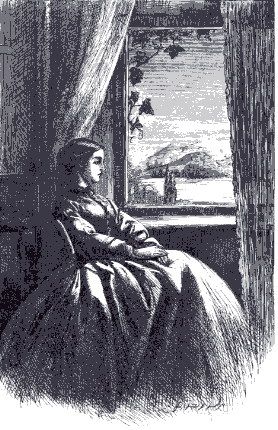 Miss E. Taylor, "Alice"
Miss E. Taylor, "Alice"
I discuss this one
at length in Trollope on the Net, Chapter 6; I think
interesting. Its in-depth psychological musing, the effective, beauty, and suggestiveness of the
clothing, the repressed sexuality, the
longing, the loss are all superb. It is a third with 'Kate'
and 'Lady Glencora' above: the ladies all in parallel positions.
No one but a woman could understand what was in the woman's
mind; Millais doesn't come near it nor Francis Montague Holl
in their depictions of Lucy Robarts and Madame Marie Goesler.
- '"Oh George", she said, "you won't do that!"'. Source: 1989
Trollope Society edition of Can You Forgive Her?, facing
p. 656.
On the other hand, this hopelessly sentimentalised
depiction of a fallen women is hilarious. 'Jane' piously holds
her hands together as if in prayer; she is all primness. He points
sternly to the money on the table. The lesson against sex is
made clear. George is well-drawn, and the disposition of the
figures projects the nadir mood of the scene.
- 'How am I to thank you for forgiving me?"'. Source: 1989 Trollope
Society edition of Can You Forgive Her?, facing p. 689.
Reprinted and discussed in Morse, Women in Trollope's Palliser's
Novels, pp. 31-33.
We return to the balcony
scene of the frontispiece; Alice is now with Grey instead of
George. I find the mood and depiction of this equally successful:
we have exchanged languor for earnestness. The two people are
now in communication, not dreaming apart.
- '"Good night, Mr Palliser"'. Source: 1989 Trollope Society edition
of Can You Forgive Her?, facing p. 700.
Our
last glimpse of Burgo from the back; we see Plantagenet extend his
hand in fellowship. The spirit of the scene is right if Plantagenet
is suddenly much older, and Burgo much smaller than in the previous
pictures. The dark wood is appropriate; this is not a comic book
at its core.
- 'Alice and Her Bridesmaids'. Source: 1989 Trollope Society edition
of Can You Forgive Her?, facing p. 724. Reprinted and
discussed in Morse, Women in Trollope's Palliser's
Novels, pp. 31-33.
I find these kinds of scenes
as depicted in the novels of the period hopelessly false; the turn
away from reality to flowerbuds and demur expressions on flat
figures all perched along an elegant stairway is striking.
- '"Yes, my bonny boy, -- you have made it right for me"'.
Source: 1989 Trollope Society edition of Can You Forgive Her?,
facing p. 736. Lady Glen's existence is now justified.
This is not as patently false as the one above. The women have
some depth of body; the looks on the faces have a certain vividness.
A great deal of effort has been expended on making the room and
furniture real.








